Neck Pain and Posture
Nov 10, 2022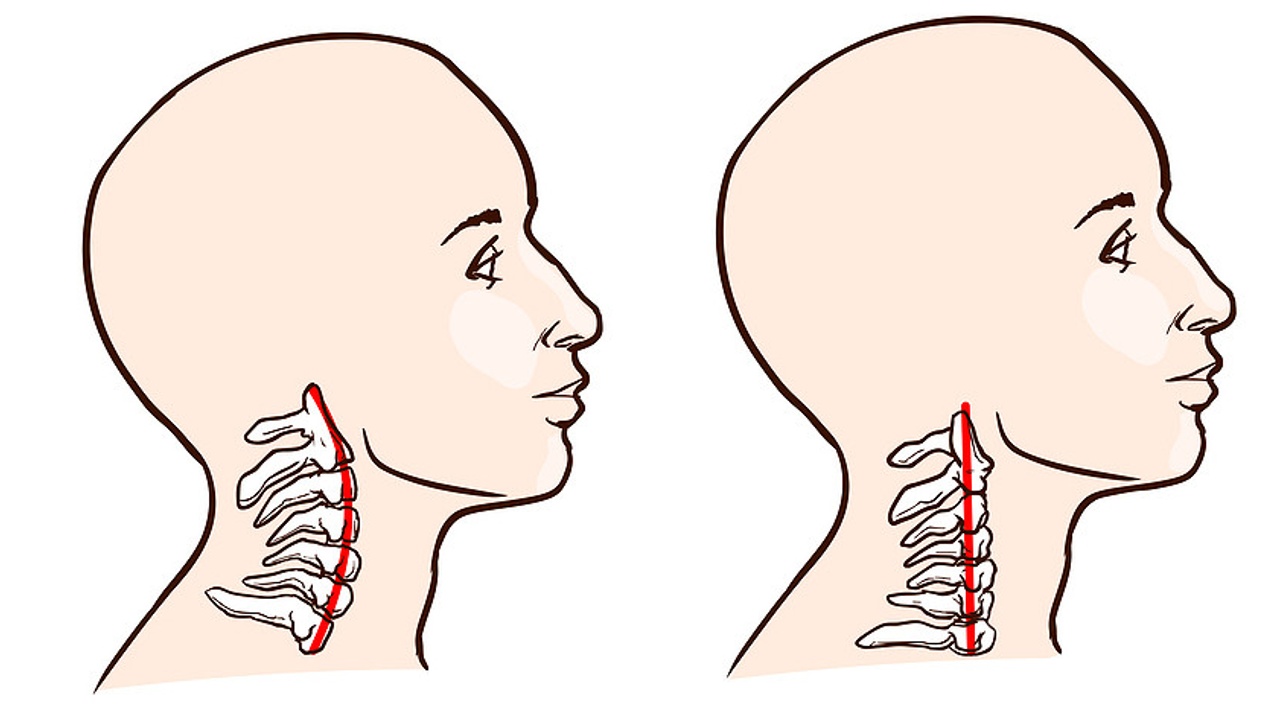
Please enjoy this guest blog by Dr. Michael L. Rothman, M.D. Dr Rothman is a former orthopedic surgeon who now helps his patients overcome chronic pain using posture alignment therapy. He is an Advanced Exercise Therapist (AET), certified by the Egoscue Institute, who practices in Albuquerque, NM. This is the first blog in a two-part series.
Two medical conditions, chronic recurrent neck pain and stiffness as well as acute non-traumatic neck pain, are quite common. In the medical world, we have noted some common causes of chronic neck pain:
- Muscle tension
- Degenerative arthritis
- Disc degeneration
- Aging
- Repetitive sprain or strain
- Psychological
Poor posture, if noted at all, is usually last on the list. However, we actually should consider it first.
Bad Posture Causes Neck Pain
Bad posture is so common these days that it is usually overlooked as a source of neck pain. Since we often overlook this issue, we often end up having unnecessary invasive procedures and medications. Our necks are an amazing section of human anatomy. Short of severe trauma that can cause major fracture dislocations and neurological injuries, the cervical (neck) spine can withstand a considerable amount of physical punishment. Although it is not fragile, it can be susceptible to chronic postural deviations intrinsic to the cervical spine and misalignments of the entire spine.
During the course of our daily ordinary activity, sports and work, the neck is subject to hundreds of different positions as well as a myriad of biomechanical stresses and strains. Bad posture is often the root cause of pain and associated degenerative pathology in the cervical spine. If the cervical spine is not properly balanced in relation to the rest of the spine below and the skull above, chronic and/or acute pain can occur. Primary dynamic muscle dysfunctions and compensations, along with secondary structural bone and joint malfunctions throughout the entire body, are major culprits in producing pain.
Major causes of poor posture in this day and age are cell phones, I-pads and computers, and prolonged sitting in awkward positions. Consider the poorly designed seats and headrests in cars, trucks, and airplanes which, over a period of time, produce abnormal spinal curves. If our bodies are not properly balanced and aligned, even the most minor physical stress to the body, such as lifting an object or a sporting activity, can cause sudden reactive pain and injury.
Typical Cell Phone/Computer/Driving Postures
 Head forward and down
Head forward and down - Neck straightened (cervical spine kyphosis)
- Rounded shoulders, and (kyphotic) thoracic (mid-back) back
- Pelvis neutral or posterior (backwards rotation)
- Compensated lumbar (lower back) curve - flat or rounded
 Flexed and rotated hips
Flexed and rotated hips- Bent knees
- Turned out feet
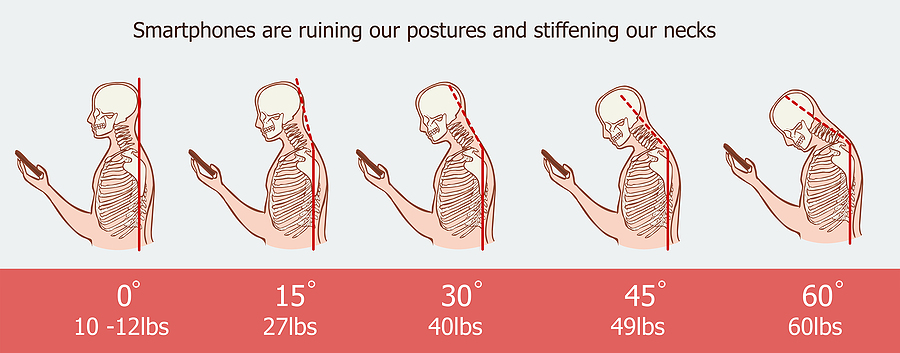
Neck Anatomy
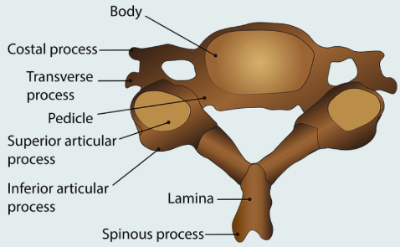 Cervical anatomy is complex. There are 7 vertebrae and 6 intervertebral discs. There are 45 muscles that control the motion and stability of the cervical spine. They can work independently or collectively. The three planes of motion of the neck are flexion and extension, rotation, and lateral bending. There are a pair of facet joints at the side of each cervical level from C2 to C7. In the figure to the right, notice the superior and inferior articular processes. The meeting of the inferior articular process on the vertebrae above with the superior articular process of the vertebrae below creates the facet joint. The contour of the facet joint is specifically designed to determine the plane and range of motion for neck movements.
Cervical anatomy is complex. There are 7 vertebrae and 6 intervertebral discs. There are 45 muscles that control the motion and stability of the cervical spine. They can work independently or collectively. The three planes of motion of the neck are flexion and extension, rotation, and lateral bending. There are a pair of facet joints at the side of each cervical level from C2 to C7. In the figure to the right, notice the superior and inferior articular processes. The meeting of the inferior articular process on the vertebrae above with the superior articular process of the vertebrae below creates the facet joint. The contour of the facet joint is specifically designed to determine the plane and range of motion for neck movements.
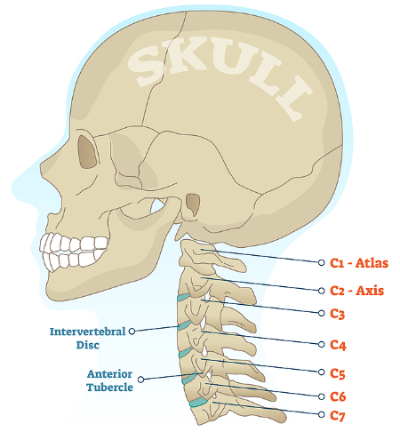 Fifty percent of all cervical rotation occurs at the atlantoaxial joint (C1-C2). Most cervical flexion and extension occurs below the atlantoaxial joint from C2 to C7. Below C2, one level cannot appreciably move without some or all of the other levels. Motion is in decreasing amounts from above downward. The joint between the skull and the first cervical vertebrae, which is called the atlanto-occipital joint, allows for about 15 degrees of flexion and extension but no rotation. The facet joints allow for lateral flexion or bending, but that motion cannot occur without rotation. I mention these anatomical features to point out how intricately the cervical spine operates. Knowledge of cervical anatomy and biokinetics helps your therapist in formulating posture specific exercise menus.
Fifty percent of all cervical rotation occurs at the atlantoaxial joint (C1-C2). Most cervical flexion and extension occurs below the atlantoaxial joint from C2 to C7. Below C2, one level cannot appreciably move without some or all of the other levels. Motion is in decreasing amounts from above downward. The joint between the skull and the first cervical vertebrae, which is called the atlanto-occipital joint, allows for about 15 degrees of flexion and extension but no rotation. The facet joints allow for lateral flexion or bending, but that motion cannot occur without rotation. I mention these anatomical features to point out how intricately the cervical spine operates. Knowledge of cervical anatomy and biokinetics helps your therapist in formulating posture specific exercise menus.
Summary of Cervical Movement
- C1-C2 (top of the neck): rotates the neck
- C2-C7: flexes and extends the neck
- C3-C7: has limited movement without involving C1 and C2
- Atlanto-occipital joint (between C1 and the skull): has 15 degrees of flexion and extension and no rotation
- Facet joints: laterally flex/bend the neck, always with rotation
- Decreasing range of motion from the top to the bottom
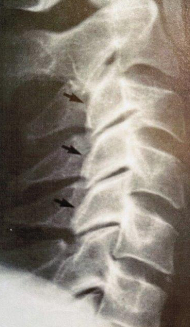
The figure to the left is an x-ray of the normal cervical spine curvature, which is called lordosis. The arrows in the back or posterior part of the spine show the gentle lordotic curve.
The figure below shows a side view of the cervical spine with the head flexed forward (picture A) and with the spine bent backwards into extension (picture B).
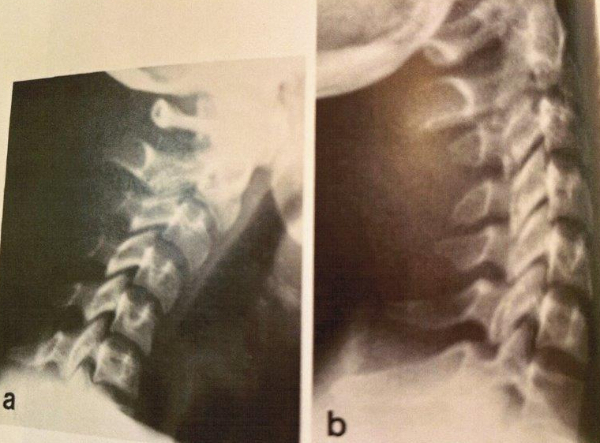
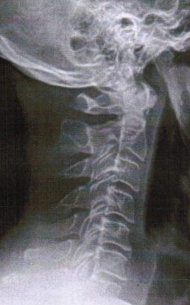 The figure to the right shows straightening of the cervical spine, which is sometimes referred to as a military neck. This can be associated with neck pain and stiffness and is sometimes combined with pain or spasm in the upper back, shoulder blades, and arms. Sensations of numbness and tingling can also happen.
The figure to the right shows straightening of the cervical spine, which is sometimes referred to as a military neck. This can be associated with neck pain and stiffness and is sometimes combined with pain or spasm in the upper back, shoulder blades, and arms. Sensations of numbness and tingling can also happen.
To understand how the entire alignment of the body influences the position of the neck, let us look at specific postural photographs.
Case Studies
Case 1
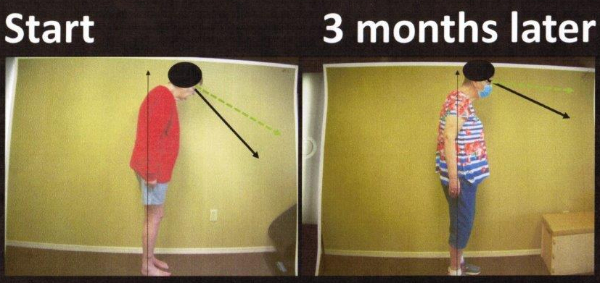
This woman is an example of extremely poor posture as a result of sitting at work in front of a computer for the last 15 years. Her head and neck are locked in a marked forward and downward position. She also has a rounded upper and middle back (thoracic kyphosis) and rounded shoulders, which further compromise the head and neck position. The low back or lumbar spine was relatively flat, despite an anterior pelvis (forward rotation). Hips were also fairly locked up. One foot was turned in and the other turned out. The long, thin, black arrow line represents the gravity line upon which her body should be totally lined up, but instead, her entire body is markedly tilted forward with loss of balance. Her neck was so stiff that her visual line was constantly directed toward the floor (thick black arrow). The dotted green line is the best visual line that could be obtained by moving her eyes upwards. Even though her head is forward and downward, the position of her cervical spine is actually straight.
Therapy and exercise to the neck alone cannot improve motion. The position and function of the cervical spine is dependent on correcting the position of the pelvis and entire spine first. After three months of proper postural corrective exercises, a more upright posture was obtained by correcting misalignments of the pelvis, thoracic and lumbar spine, and shoulders. A lot of the military neck was converted to a more lordotic curve, with relief of pain along with significant line of vision improvement. It took a lot of dedication and discipline on her part to go through the program, but it paid great dividends.
Case 2
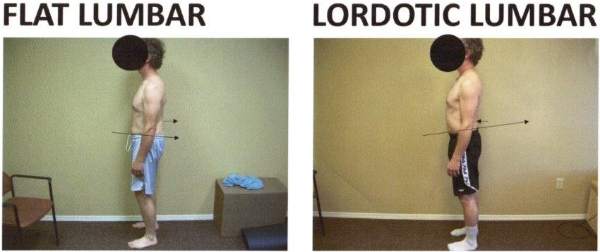
This male is another example of poor posture, balance and alignment in a 40-year-old carpenter. He was constantly in awkward positions at work, resulting in both severe neck, low back pain, and sciatica. The position of his legs and feet were rotated outward, along with a posterior tilted pelvis and a flat lumbar spine. This, in combination with rounding throughout his mid to upper back and shoulders, contributed to his forward neck position. The cervical spine did not show a military position but nevertheless was quite painful and stiff. After two or three months of appropriate posture improvement exercises, you can see the dramatic improvement in his alignment from head to toe. Additionally, he had complete relief of pain in all areas.
The two cases outlined above that pertain to the connection between neck pain and total body poor posture are extreme examples. Most individuals fall into more subtle and less obvious postural deviations that cause neck pain. The figures below show typical examples of compromised posture that causes neck pain, muscle tension and/or spasm and stiffness. Posture deviations shown in the figures from the head down include the following:
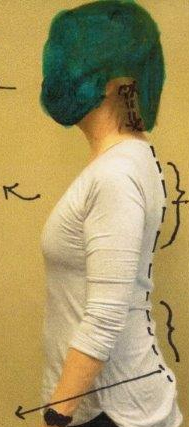
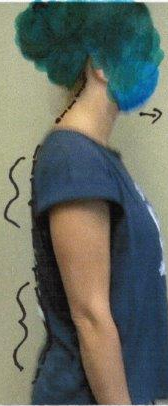
- Head forward
- Cervical spine between straight and slightly lordotic
- Rounded shoulders
- Thoracic kyphosis
- Lumbar lordosis
- Anterior pelvic tilt
- Torso rotation (left figure)
This posture is so common that one would not think much about it. Properly applied postural therapy exercise to correct ALL of these misalignments and imbalances is the only solution.
 A classic example concerning the spinoff of poor posture is the gymnast, shown to the right, who began gymnastics at age 13. In addition to neck issues, hip and low back problems also existed on a constant basis, despite daily workouts and lots of weight training. Note all of the postural deviations drawn on the photo. For years she has felt out of balance and crooked but did not know how to fix it. Despite being a highly skilled athlete, a major knee injury also occurred. Of note is that she used her cell phone and her computer a lot over the years and thus had the incorrect postures that accompany those activities. She has successfully started her postural and functional restoration program with excellent early results and is looking forward to complete recovery.
A classic example concerning the spinoff of poor posture is the gymnast, shown to the right, who began gymnastics at age 13. In addition to neck issues, hip and low back problems also existed on a constant basis, despite daily workouts and lots of weight training. Note all of the postural deviations drawn on the photo. For years she has felt out of balance and crooked but did not know how to fix it. Despite being a highly skilled athlete, a major knee injury also occurred. Of note is that she used her cell phone and her computer a lot over the years and thus had the incorrect postures that accompany those activities. She has successfully started her postural and functional restoration program with excellent early results and is looking forward to complete recovery.
Posture Correction is Important for Youth
Now that we have covered an intriguing variety of neck pain cases and postural solutions, let's backtrack in age to youngsters and young adults that are in posture trouble and do not yet know it. Take a look at the following children, ages 12 on the left and 19 on the right.
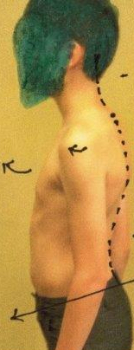
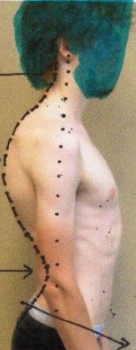 Neither of these folks has any pain, but they will as they get older. These postures are a modern day result of cell phones, video games and computers, often combined with improper physical fitness and athletic conditioning training. The 12-year-old on the left is starting to develop exaggerated thoracic and lumbar curves that will eventually also affect his neck, but if postural restoration is started now, it can be corrected to prevent what is seen in the 19-year-old on the right. The posture in the 19-year-old began at age 10 or younger and gradually progressed into a major problem to correct with potential long-term consequences. So, the sooner this type of posture is identified in young kids, the better the results to prevent misery into adulthood. Unfortunately, this situation has become so common that it is not recognized as a significant problem. Please be aware and vigilant for your family and friends, though. Do not be fearful of speaking out. You may do somebody a huge favor.
Neither of these folks has any pain, but they will as they get older. These postures are a modern day result of cell phones, video games and computers, often combined with improper physical fitness and athletic conditioning training. The 12-year-old on the left is starting to develop exaggerated thoracic and lumbar curves that will eventually also affect his neck, but if postural restoration is started now, it can be corrected to prevent what is seen in the 19-year-old on the right. The posture in the 19-year-old began at age 10 or younger and gradually progressed into a major problem to correct with potential long-term consequences. So, the sooner this type of posture is identified in young kids, the better the results to prevent misery into adulthood. Unfortunately, this situation has become so common that it is not recognized as a significant problem. Please be aware and vigilant for your family and friends, though. Do not be fearful of speaking out. You may do somebody a huge favor.
A very important point to emphasize is that once your posture is corrected to relieve pain and restore really good function, it is crucial to continue postural exercises for the rest of your life. Maintenance of what you accomplished is key. Continue to be an overcomer. It does not happen without effort. It is a lifestyle change. Think out of the box. Good posture and motion are the foundation that enables you to successfully engage in any other activity, from driving a car comfortably to high demand athletic endeavors.
I hope that this brief presentation on the cause and effect of chronic and sometimes acute neck pain has been informative. The object is to make your body whole again without medications, surgery, or other invasive procedures.
Stay tuned for next month’s blog that will cover exercises for neck pain and posture.
Stay connected with news and updates!
Join our mailing list to receive the latest news and updates from me.
Don't worry, your information will not be shared.
We hate SPAM. We will never sell your information, for any reason.

